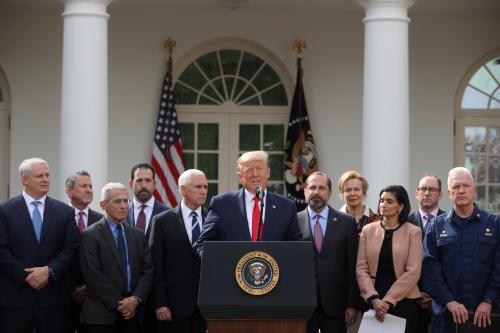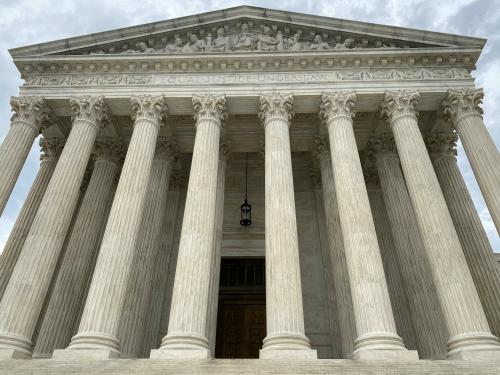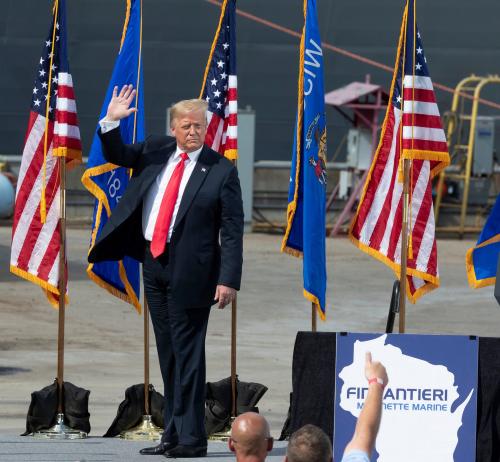What would happen if President Trump contracted COVID-19? This is more than a hypothetical question. Cases are surging throughout the United States. Leaders at home and abroad have come down with the virus. Miami Mayor Francis Suarez and Atlanta Mayor Keisha Lance Bottoms have both been diagnosed with COVID-19, as have UK Prime Minister Boris Johnson and Brazilian President Jair Bolsonaro. Several members of the White House staff as well as numerous Secret Service agents have also been stricken.
Given the president’s near-refusal to wear protective gear, unwillingness to socially distance, and commitment to holding in-person rallies, it’s possible that the president himself could contract the illness. Presidential illness is not something commonly discussed, but procedures are in place to deal with a variety of scenarios that protect the president, the integrity of the office, and the continuity of government.
A positive test for the president
A positive COVID-19 test for the president, in itself, is not a cause for emergency action. Millions of people around the world have contracted the disease and have been asymptomatic or mildly symptomatic. The president would likely be able to continue his everyday activities and manage the office either undisturbed or with mild challenges. A presidential diagnosis would create some challenges for those around him. The need for 24-hour Secret Service protection could put agents at risk for contracting it. But given modern technology, the president could quarantine and have remote or sufficiently distanced contact from most, if not all, aides, including the individual(s) who would be involved in the presidential daily brief.
There would need to be other precautions taken, even if the president were to be asymptomatic. First, those in the line of succession would need to be protected. It would be important to keep Vice President Pence, Speaker Pelosi, Senator Grassley (President Pro Tempore), and members of the cabinet isolated from the president. It would be especially important to ensure that the vice president have limited contact with individuals generally to reduce his chances of contracting the virus as well.
Second, it would be important for the president to continue to communicate with the American public, especially if he is mildly symptomatic or asymptomatic. Seeing the president on camera can restore faith in his wellness, calm nervous Americans, stabilize stock markets (that would surely see a dip in the event of a positive test), and project to the world that the president remains well enough to execute the office.
We’ve experienced something like this before. In 1919, President Woodrow Wilson suffered a serious stroke, and his wife kept even his closest advisers from seeing the president, likely out of fear that they would find him incapacitated and thus throwing the nation into a serious leadership crisis. Such a scenario (hiding the president’s condition) would not be possible today, but an extended absence of a president—especially during a pandemic—would raise serious questions and become a destabilizing force in politics, the economy, and the public.
Contingencies for a seriously ill president
Although the president has access to some of the best and most immediate health care in the world, his age and obesity put him into higher risk categories for more serious symptoms for COVID-19. Patient experiences range dramatically, but some of the most serious courses of treatment include use of a ventilator. When a patient is put on a ventilator, the patient is non-verbal because of the insertion of the tube through the vocal cords and they are given some level of sedation, ranging from minimal to deep sedation. During this time, a patient’s cognitive abilities would at least be affected or completely absent. More intensive sedation therapies, including drug-induced paralysis, can be used in the treatment of severe COVID-19 complications.
In an unfortunate scenario in which the president were to contract COVID-19 and need therapies such as a ventilator and/or the use of other therapies that would impair his cognitive abilities and/or abilities to communicate, there are a few procedures in place to deal with that situation. If the president is given notice that he is to be administered therapies that will impair his ability to perform the duties of office—for functional reasons, cognitive reasons, or both—under Section 3 of the 25th Amendment to the Constitution, the president can transmit to the House and Senate “his written declaration that he is unable to discharge the powers and duties of his office.”
The invocation of Section 3 of the 25th Amendment has happened multiple times. President Reagan did so in 1985 and President George W. Bush did so twice in 2002 and 2007. Each time was for medical procedures in which anesthesia or heavy sedation was used. President Clinton likely should have invoked Section 3 during a 1997 knee surgery, but opted not to, claiming he was never put under general anesthesia. When Section 3 is invoked, the vice president becomes “acting president” until the president notifies the House and Senate that he is able to perform his duties once again.
In the event that the president were sick, his condition declined rapidly, and he was unable to invoke Section 3 of the 25th Amendment, Section 4 provides a solution to such a crisis. Under Section 4, the vice president and a majority of the cabinet can send notice to the House and Senate “that the President is unable to discharge the powers and duties of his office.” And as in the case of invoking Section 3, the vice president will serve as acting president. Once a president recovers, he can transmit that to the House and Senate, and he will re-take the powers unless the vice president and a majority of the cabinet tell Congress that the president remains incapacitated—at which point Congress would vote on incapacity.
The latter is the intended use of Section 4 of the 25th Amendment. While some of the president’s opponents have fantastically called for the vice president and cabinet to declare the president incapacitated based on disagreements with his behaviors, amateur diagnoses of non-specific medical issues, or dissatisfaction with his temperament, that should not diminish the importance of the provisions of Section 4. There can be real scenarios in which the president’s medical condition suddenly creates an incapacity, and in that situation, the country will have an individual who is able to execute the full powers of the office of president—in that case, Acting President Mike Pence. While presidential incapacity would be a serious national situation, the government would be able to function in a largely uninterrupted way until the president is recovered.
The author thanks Geoffrey Frattalone, RN for his assistance with this piece.
The Brookings Institution is committed to quality, independence, and impact.
We are supported by a diverse array of funders. In line with our values and policies, each Brookings publication represents the sole views of its author(s).








Commentary
What happens if President Trump contracts COVID-19
July 8, 2020